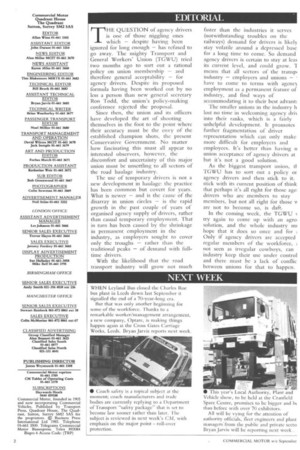EDITORIAL
Page 4

If you've noticed an error in this article please click here to report it so we can fix it.
THE QUESTION of agency drivers is one of those niggling ones which — despite having been ignored for long enough — has refused to go away. The mighty Transport and General Workers' Union (TGWU) tried two months ago to sort out a rational policy on union membership — and therefore general acceptability — for agency drivers. Despite its proposed formula having been worked out by no less a person than new general secretary Ron Todd, the union's policymaking conference rejected the proposal.
Since then, the union and its officers have developed the art of shooting themselves in the foot to the point where their accuracy must be the envy of the established champion shots, the present Conservative Government. No matter how fascinating this must all appear to interested observers, however, the discomfort and uncertainty of this major union must be unsettling to all sectors of the road haulage industry.
The use of temporary drivers is not a new development in haulage: the practice has been common but covert for years. What is newer — and is the cause of the disarray in union circles — is the rapid growth in the past couple of years of organised agency supply of drivers, rather than casual temporary employment That in turn has been caused by the shrinkage in permanent employment in the industry, as employers sought to cover only the troughs — rather than the traditional peaks — of demand with fulltime drivers.
With the likelihood that the road transport industry will grow not much faster than the industries it serves (notwithstanding troubles on the railways) demand for drivers is likely stay volatile around a depressed base for a long time to come. So demand agency drivers is certain to stay at leas its current level, and could grow. 1 means that all sectors of the transpi industry — employers and unions — • have to come to terms with agenc). employment as a permanent feature of industry, and Find ways of accommodating it to their best advant The smaller unions in the industry la lost no time in welcoming agency dri\ into their ranks, which is a fairly unhelpful development. It promotes further fragmentation of driver representation which can only make more difficult for employers and employees. It's better than having n union acceptance of agency drivers at but it's not a good solution.
As the biggest transport union, tf TGWU has to sort out a policy or agency drivers and then stick to it. stick with its current position of think that perhaps it's all right for those age] drivers who are members to stay members, but not all right for those v are not to become so, is daft.
In the coming week, the TGWU try again to come up with an agrel solution, and the whole industry mi hope that it does so once and for ; Only if agency drivers are accepted regular members of the workforce, not seen as irregular cowboys, can industry keep their use under control and there must be a lack of conflic between unions for that to happen.




































































































